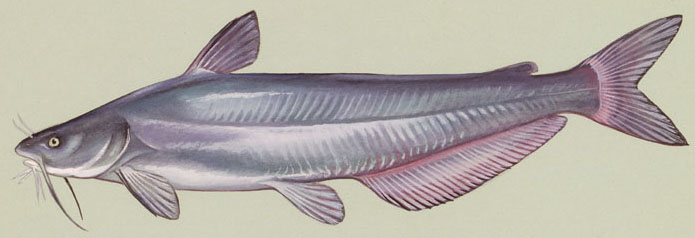Facts for Kids
Blue catfish are large freshwater fish known for their distinctive bluish hue and are a popular species in recreational fishing.
Overview
Ecological Role
Habitat And Range
Conservation Status
Cultural Significance
Physical Characteristics
Diet And Feeding Behavior
Fishing And Culinary Uses
Reproduction And Lifespan

Inside this Article
Southern United States
Mississippi River
Sense Of Smell
United States
Population
Catfish
Sport
Food
Time
Did you know?
🐟 Blue catfish can grow up to 50 inches in length and weigh over 100 pounds.
🎣 They are commonly found in freshwater rivers and lakes in North America.
🌊 Blue catfish prefer deep waters with a muddy bottom for shelter.
🦈 This species is known for its long, slender body and forked tail.
🍽️ Blue catfish are opportunistic feeders, mainly consuming fish, crustaceans, and aquatic insects.
🚤 They are a popular target for sport fishing due to their size and fighting ability.
🛰 Blue catfish can be identified by their bluish-gray coloration and white belly.
🌡️ They thrive in warmer waters, typically preferring temperatures between 70°F and 85°F.
💧 Blue catfish are sensitive to changes in their environment, especially oxygen levels.
🐡 They spawn from April to July, with females laying up to 100,000 eggs at a time.
Introduction
They are named for their bluish-gray color and can grow to be very big, sometimes over 5 feet long! These fish live in rivers and lakes, particularly in the Mississippi River and its tributaries. They are popular among anglers who love catching large fish. With their long, pointed fins and smooth skin, blue catfish are really interesting to watch underwater. Did you know they can weigh over 100 pounds? That's a lot of fish! 🎣
Ecological Role
As predators, they help control the population of smaller fish and other aquatic creatures. This balance is crucial for healthy ecosystems in rivers and lakes. Additionally, they are food for larger animals like birds and other fish, making them a key part of the food chain. By keeping populations in check, blue catfish help maintain the health of their habitats! 🦅
Habitat And Range
They love areas with deep water and plenty of food, like the Mississippi River Basin, including states like Missouri, Illinois, and Tennessee. But they can also be found as far north as the Great Lakes region! When they aren’t in rivers or lakes, they may be spotted in ponds too. These fish prefer habitats with rocky or sandy bottoms where they can hide and hunt. 🐠
Conservation Status
However, it’s important to manage fishing practices so that their populations stay healthy. Some states have specific regulations to protect them, such as size limits and catch limits. Conservationists are always working hard to keep rivers and lakes clean so blue catfish and other wildlife can thrive! 🚮
Cultural Significance
They are featured in folklore and regional stories. Also, they symbolize strength and resilience because of their size and ability to survive in various habitats. Festivals celebrating blue catfish and fishing competitions showcase community spirit and pride in local traditions. So next time you hear a story about a huge fish caught in a river, it might just be a blue catfish! 🎣✨
Physical Characteristics
They also have long whisker-like structures called barbels on their faces, which help them find food. Blue catfish have a unique, forked tail that helps them swim quickly in the water. Their eyes are not very big, but their sense of smell is excellent! This helps them sniff out delicious snacks from far away! 👀✨
Diet And Feeding Behavior
They are carnivorous, meaning they eat meat, and they use their sharp teeth to catch their prey. During the night, they usually start hunting because they can see better in the dark. They can consume a lot of food, which helps them grow! Blue catfish can sometimes even eat fish larger than their mouths! 😲
Fishing And Culinary Uses
Blue catfish are known for their tasty, firm flesh, making them a favorite dish in many southern U.S. kitchens. Restaurants often serve them fried, grilled, or in stews. In fact, in some places like the Carolinas, you can find blue catfish festivals celebrating this delicious fish! 🌟
Reproduction And Lifespan
They usually spawn (have babies) during the warmer months, specifically from May to July. Females will lay thousands of eggs in nests made by the males. The males are very protective and guard the eggs until they hatch! The baby fish, known as fry, grow fast as they learn to find their own food and become independent. 🐟

